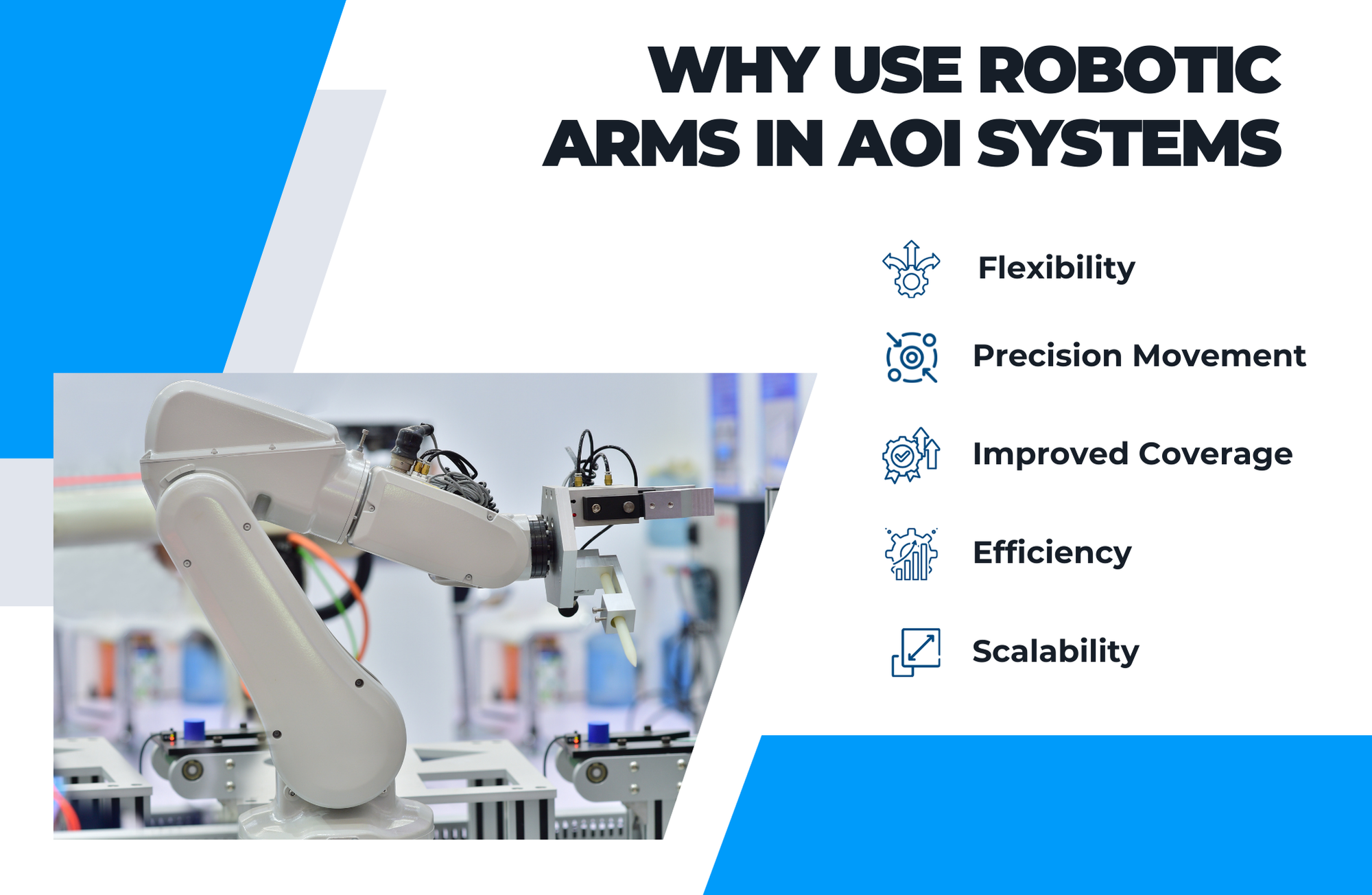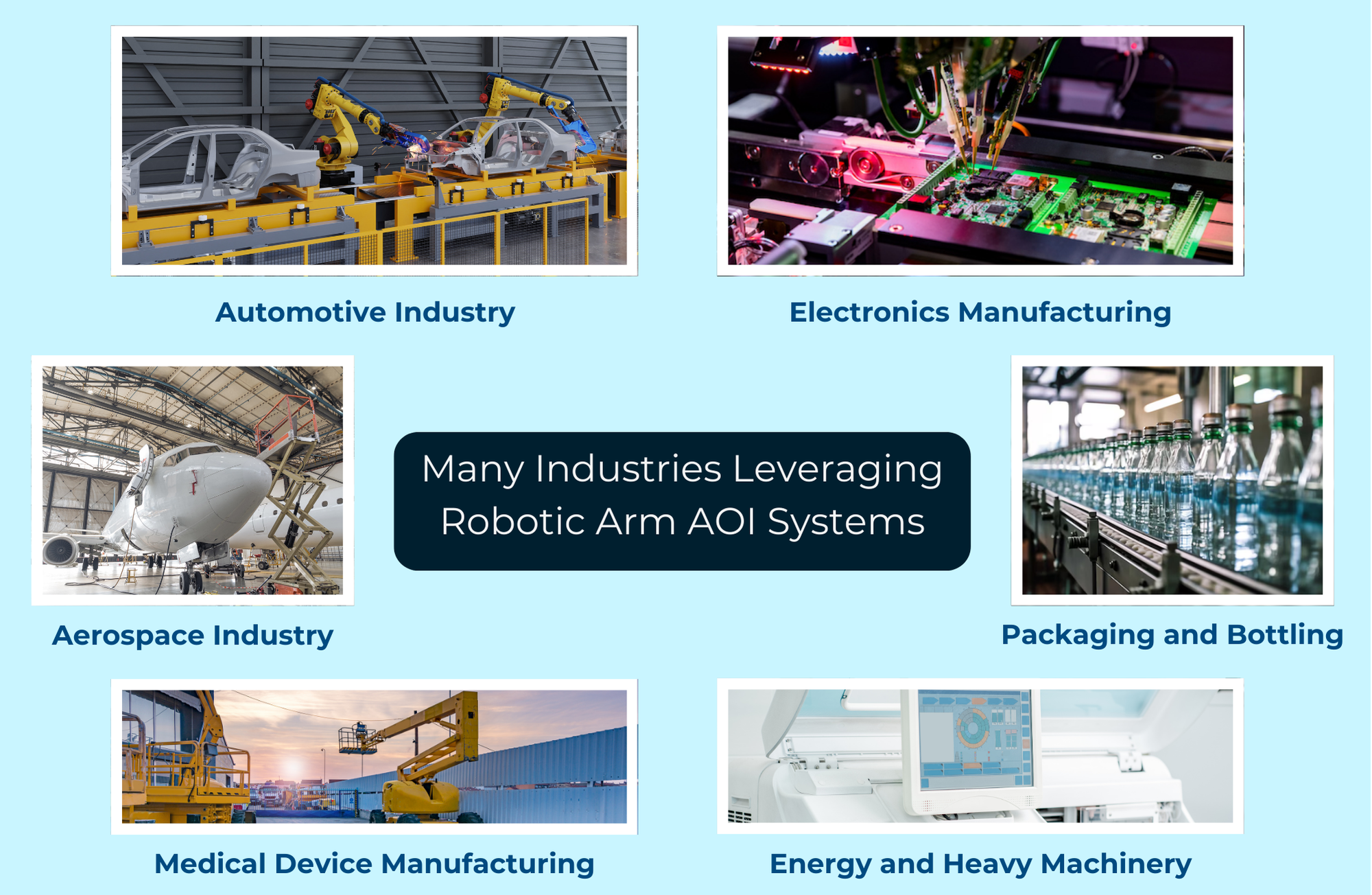Robotic Arm in AOI System Development
Published on: Dec 26, 2024

Written by: Team Intelgic
The Role of Robotic Arms in Automated Optical Inspection (AOI) Systems
In modern manufacturing, Automated Optical Inspection (AOI) systems are critical for maintaining product quality and efficiency. These systems use advanced imaging and AI-powered algorithms to detect defects and measure dimensions with precision. Robotic arms have become an integral part of AOI systems, enhancing their functionality, adaptability, and scalability.
 Systems.png)
Applications of Robotic Arms in AOI Systems
1. Multi-Angle and 360-Degree Inspection
- Robotic arms position cameras and lighting to capture images from multiple angles, ensuring comprehensive coverage of all surfaces.
- Ideal for inspecting parts with complex shapes, such as cylinders, gears, and automotive components.
2. Large Part Inspection
- For large or irregularly shaped parts, robotic arms move inspection equipment around the object to inspect hard-to-reach areas.
- Examples: Automotive body panels, aerospace components, and machinery parts.
3. Dynamic Part Handling
- Robotic arms pick up, rotate, and reposition parts during the inspection process to expose all sides.
- Useful for products that require inspection of both internal and external surfaces, such as tubes, bottles, and containers.
4. Integration with Machine Vision
- Robotic arms equipped with vision sensors can guide cameras to specific areas of interest, enabling targeted inspections based on AI-detected anomalies.
5. High-Speed Inspection
- In fast-paced production environments, robotic arms synchronize with conveyors to inspect parts in motion without slowing down production.
6. Precision Measurement
- Robotic arms hold measurement tools such as laser profilers or 3D sensors at precise angles to capture dimensional data for quality control.
7. Defect Marking and Sorting
- After defect detection, robotic arms can mark defective parts or remove them from the production line for further analysis or rework.
Why Use Robotic Arms in AOI Systems?
Robotic arms enhance AOI systems by adding flexibility, precision, and automation to the inspection process. They address challenges that static or conveyor-based systems might face, such as accessing hard-to-reach areas, adapting to various part sizes, and handling complex inspection workflows.
Key Benefits of Robotic Arms in AOI Systems
- Flexibility:
- Robotic arms can be programmed to handle diverse inspection tasks, including scanning complex geometries, inspecting large components, and repositioning parts for complete coverage.
- Precision Movement:
- Ensures consistent positioning of cameras, lights, and other inspection equipment, reducing errors caused by misalignment.
- Improved Coverage:
- Accesses hard-to-reach areas and inspects all sides of an object by moving cameras and lighting around the part.
- Efficiency:
- Automates repetitive tasks such as part handling, camera positioning, and lighting adjustments, increasing throughput and reducing manual labor.
- Scalability:
- Easily integrates into existing AOI systems, enabling manufacturers to inspect a wide range of products with minimal reconfiguration.

Components of a Robotic Arm AOI System
1. Robotic Arm
- Degrees of Freedom:
- Most robotic arms in AOI systems have 6 or more degrees of freedom, allowing them to move in multiple directions and orientations.
- Payload Capacity:
- Selected based on the weight of the inspection equipment and parts to be handled.
2. Machine Vision Cameras
- High-Resolution Cameras:
Capture detailed images for defect detection and dimensional analysis. - 3D Vision Systems:
Enable depth measurement and inspection of complex geometries.
3. Advanced Lighting
- Diffuse Lighting:
- Provides even illumination for reflective surfaces.
- Directional Lighting:
- Highlights surface defects like scratches and dents.
4. AI-Powered Software
- Defect Detection Algorithms:
- Analyze captured images to identify anomalies.
- Motion Synchronization:
- Integrates with robotic arm movements for real-time inspection.
5. Controller and Sensors
- Controller:
- Programs and synchronizes the robotic arm with the AOI system.
- Proximity and Position Sensors:
- Ensure accurate positioning of the robotic arm and inspection equipment.
Many Industries Leveraging Robotic Arm AOI Systems
1. Automotive Industry
- Inspection of engine components, body panels, and chassis for scratches, dents, and dimensional accuracy.
2. Electronics Manufacturing
- Inspecting solder joints, circuit boards, and connectors for defects and alignment.
3. Aerospace Industry
- Ensuring defect-free surfaces and precise dimensions in turbine blades, fuselage components, and landing gear.
4. Packaging and Bottling
- Verifying label placement, seal integrity, and surface defects on containers and bottles.
5. Medical Device Manufacturing
- Inspecting syringes, implants, and diagnostic devices for contamination, cracks, or dimensional inaccuracies.
6. Energy and Heavy Machinery
- Inspecting large gears, turbines, and pressure vessels for structural defects and wear.

Advantages of Robotic Arm AOI Systems
1. Enhanced Accuracy
- Robotic arms ensure consistent positioning and movement, improving the accuracy of defect detection and measurement.
2. Increased Throughput
- Automates repetitive inspection tasks, reducing inspection time and increasing production speed.
3. Cost Savings
- Minimizes manual labor and rework by detecting defects early in the production process.
4. Versatility
- Easily adapts to inspect different parts, sizes, and materials, making it suitable for diverse production lines.
5. Real-Time Feedback
- Provides instant insights into product quality, enabling quick corrective actions.
Considerations for Implementing Robotic Arm AOI Systems
- Part Complexity:
- Ensure the robotic arm has sufficient degrees of freedom to handle complex inspection tasks.
- Integration with Existing Systems:
- Verify compatibility with existing production lines, machine vision cameras, and AI software.
- Speed Requirements:
- Choose a robotic arm capable of operating at the required speed without compromising accuracy.
- Environmental Conditions:
- Ensure the system is designed to withstand heat, dust, or vibrations in the production environment.
- Training and Calibration:
- Regularly calibrate the robotic arm and train AI models to maintain inspection accuracy.
Robotic arms are transforming the capabilities of Automated Optical Inspection (AOI) systems, offering precision, flexibility, and scalability in diverse manufacturing environments. By integrating robotic arms with machine vision cameras and AI-powered defect detection software, manufacturers can achieve comprehensive and efficient inspection processes that ensure product quality and reliability.
Intelgic specializes in designing and implementing custom AOI systems with robotic arms, tailored to meet the unique needs of your production line. Contact Intelgic today to learn how our solutions can enhance your inspection processes and drive operational excellence.

